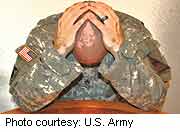
MONDAY, March 3, 2014 (HealthDay News) — Three new studies suggest that a sizeable percentage of American soldiers suffer from some type of mental health issue, at rates higher than those seen in the general population.
“Some of the differences in disorder rates are truly remarkable,” Ronald Kessler, a professor of health care policy at Harvard Medical School and senior author of one of the studies, said in a Harvard news release. “The rate of major depression is five times as high among soldiers as civilians, intermittent explosive disorder six times as high, and post-traumatic stress disorder [PTSD] nearly 15 times as high.”
Two of the three studies relied on data from the STARRS survey, a major research effort involving almost 5,500 soldiers. The survey is a collaborative effort between the U.S. Army and the U.S. National Institute of Mental Health (NIMH).
All of the studies were released online March 3, but were slated for publication later this week in the journal JAMA Psychiatry.
In Kessler’s study, a full quarter of active duty, non-deployed Army soldiers tested positive for at least one psychiatric disorder after taking a mental health assessment exam. Eleven percent showed signs of more than one psychiatric condition, the researchers found.
Conditions that had their onset prior to enlistment in the Army included major depression, bipolar disorder, anxiety disorders, panic disorder and PTSD, the researchers found. Conditions such as attention-deficit/hyperactivity disorder (ADHD), “intermittent explosive [anger] disorder,” and problems with alcohol and/or drug use — were also common.
Overall, close to 13 percent of the soldiers examined had mental health impairments that were serious enough to compromise their ability to carry out their Army roles, the research team reported.
The findings “might be useful to the Army in developing targeted outreach intervention programs for new soldiers such as interventions for ADHD and for problems with anger management,” the researchers said.
A second study, led by Harvard researcher Matthew Nock, looked more closely at the link between mental illness before enlistment in the Army and the risk for suicide.
Army suicides have increased in recent years for unknown reasons, the researchers noted.
Using STARRS survey data, Nock’s team found that about 14 percent of soldiers said they had had suicidal thoughts, 5.3 percent had planned suicide and 2.4 percent had made actual attempts.
In almost 60 percent of cases, soldiers who had attempted suicide had mental disorders that seemed to have begun before their enlistment in the Army, the research team noted. The suicide rate for Army personnel now exceeds that of the general population, they added.
“These results are a wake-up call highlighting the importance of outreach and intervention for new soldiers who enter the Army with pre-existing mental disorders,” Robert Ursano, chair of the department of psychiatry at the Uniformed Services University of the Health Sciences and co-principal investigator of the Army STARRS survey, said in the Harvard news release.
A third study, led by NIMH researcher Michael Schoenbaum, looked at risk factors that might predict soldiers at higher risk for suicide. Reviewing data on almost 1 million Army soldiers on active duty between 2004 and 2009, the researchers found a rise in suicide rates between those years, in currently and previously deployed soldiers.
Those at highest risk for suicide were white males, soldiers at a junior enlisted rank, and soldiers who had recently been demoted, Schoenbaum’s team said.
More information
Learn about the warning signs of suicide at the American Psychological Association.
Copyright © 2025 HealthDay. All rights reserved.

